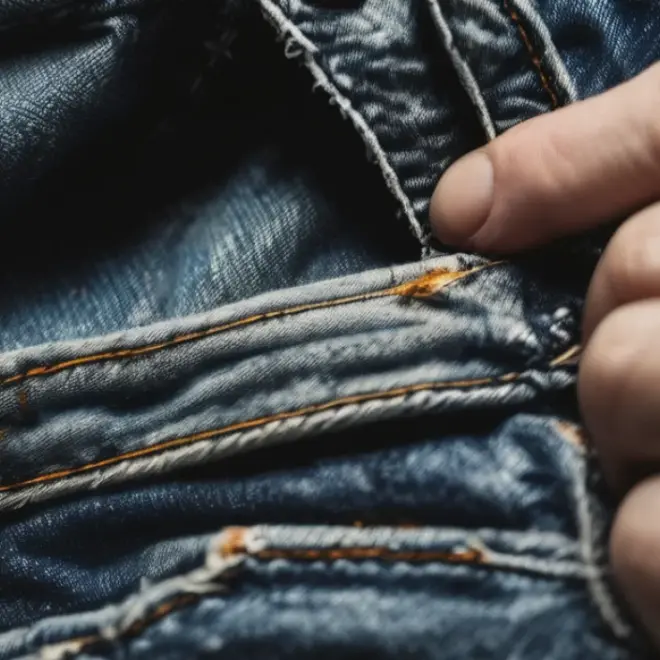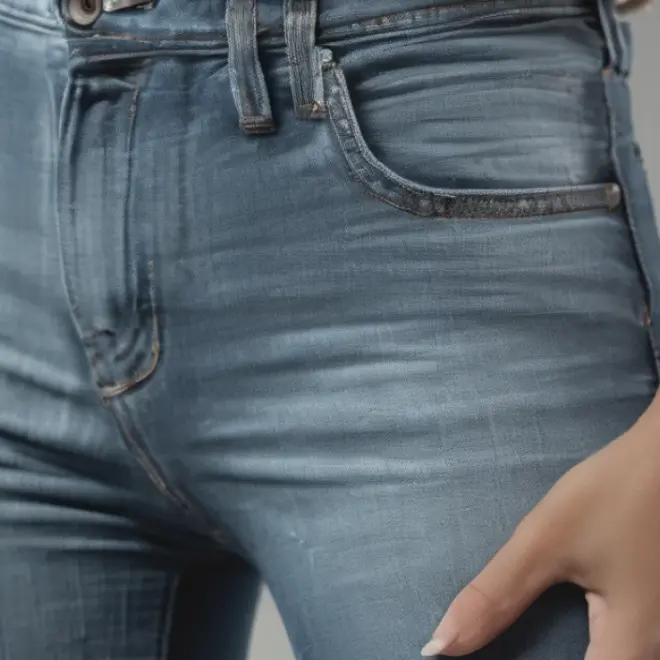Is your favorite pair of bootcut jeans too long? Learn how to hem them easily using the proven vinegar method. This simple technique shrinks your jeans slightly, creating a perfect fit without any sewing required. Get ready for perfectly fitting jeans that look tailor-made!
How to Hem Bootcut Jeans: The Proven Vinegar Method for a Perfect Fit
It’s a common frustration: your favorite bootcut jeans have the perfect rise, the ideal wash, but they drag on the floor. Too-long jeans can look sloppy, get ruined quickly, and make walking a tripping hazard. But before you reach for the scissors or plan a trip to the tailor, consider a surprisingly effective, no-sew solution: the vinegar method. This technique uses a natural household ingredient to slightly shrink your denim, giving you that custom-fit look with minimal effort. Let’s walk through how to get your bootcut jeans to the perfect length, just like a knowledgeable friend would guide you.
Why the Vinegar Method Works for Hemming
The magic behind the vinegar method lies in how it interacts with denim fibers. When you soak jeans in a vinegar and water solution, especially warm water, it can cause a slight contraction of the cotton threads. This isn’t about drastic shrinkage like you might get from a hot dryer cycle; it’s a controlled, subtle way to shorten your jeans. For bootcut styles, this gentle shrink can be just enough to lift the hem off the floor and prevent fraying or further stretching. It’s a fantastic option for those who want to avoid sewing or are unsure about cutting their beloved denim.
Understanding Bootcut Jeans and Hemming Challenges
Bootcut jeans are designed with a subtle flare at the ankle. This shape means the hemline needs to be precise. If they’re too long, they can overwhelm your shoes and create a messy silhouette. Hemming them yourself can be tricky because:
- Uneven Shrinkage: Traditional washing and drying can sometimes lead to uneven shrinkage, making one leg shorter than the other.
- Loss of Original Hem: Cutting off the original hem means losing that distinctive, often slightly worn look that adds character to jeans.
- Sewing Difficulty: Denim is thick, and sewing a clean, even hem can be challenging without the right tools or experience.
The vinegar method sidesteps these issues by offering a gentle, consistent way to adjust the length without altering the original hemline.
Materials You’ll Need
Gathering your supplies is simple. You likely already have most of what you need around the house:
- Your Bootcut Jeans: The stars of the show! Ensure they are made of 100% cotton or a high cotton blend for best results.
- White Vinegar: Standard distilled white vinegar works perfectly.
- Warm Water: Not boiling, but comfortably warm to the touch.
- A Large Basin or Bathtub: Big enough to submerge your jeans completely.
- Measuring Tape or Ruler: To check the current length and desired final length.
- Marker or Fabric Chalk: To mark your desired hem line before washing.
- A Dryer (use with caution): Optional, for influencing the outcome.
- A Flat Surface: For measuring and drying your jeans.
Step-by-Step: The Vinegar Hemming Process
Follow these straightforward steps to achieve perfectly hemmed bootcut jeans. Remember, patience is key here, as is attention to detail during the measuring phase.
Step 1: Measure and Mark Your Desired Length
First, put on the shoes you typically wear with your bootcut jeans. This is crucial for accurate hemming. Stand in front of a mirror and adjust the jeans until they sit perfectly. You want the hem to graze the top of your shoes or have a slight break. Use your marker or chalk to mark where you want the new hem to fall. Now, take the jeans off. Lay them flat on a surface, aligning the inseams and outseams carefully. Use your measuring tape to measure from the crotch seam down to the marked line on each leg. This measurement is your target length.
Step 2: Prepare the Vinegar Solution
In your basin or bathtub, mix one part white vinegar with two parts warm water. For example, if you’re using a gallon of water, add half a gallon of vinegar. A common ratio that works well is roughly 2 cups of vinegar to 4 cups of warm water for a single pair of jeans. Ensure there’s enough solution to fully submerge both pant legs.
Step 3: Submerge the Jeans
Carefully place your bootcut jeans into the vinegar and water solution. Make sure both legs are fully saturated. Gently swish them around to ensure the solution penetrates the fabric evenly. Leave the jeans to soak for at least 30 minutes, and up to an hour. For a more significant slight shrink, you can extend the soaking time, but avoid excessively long soaks (over several hours), as this can weaken the fibers.
Step 4: Rinse and Gently Wring
After soaking, lift the jeans out of the solution. You don’t need to rinse them thoroughly with plain water immediately. Instead, gently wring out the excess liquid from the legs. The goal is to leave some of the vinegar solution in the fabric to work its magic during the drying process.
Step 5: Hang or Lay Flat to Dry (Crucial Step!)
This is where you have a choice that can influence the outcome:
- Option A: Hang Dry (for minimal shrinkage): Hang your jeans by the waistband on a sturdy hanger. Ensure the legs hang straight down. This method encourages natural drying with minimal fabric manipulation, leading to a more subtle length adjustment. This is often preferred for bootcut jeans to maintain their shape.
- Option B: Lay Flat (for more control): Lay your jeans flat on a clean surface, smoothing out any wrinkles. Arrange them so the legs hang freely off the edges. This method also helps maintain shape and allows for better control over the drying process.
Avoid putting them in a washing machine at this stage, as vigorous agitation can lead to uneven results.
Step 6: Check the Length
Once the jeans are completely dry, try them on with your chosen shoes. They should have slightly shrunk. If they are now the perfect length, congratulations! If they are still a little too long, you can repeat the soaking process, perhaps extending the soaking time slightly or using a slightly warmer water temperature.
Step 7: The Dryer (Optional and With Caution)
Some individuals choose to use the dryer to set the shrinkage or achieve a more pronounced effect. If you opt for this:
- Ensure the jeans are lightly damp, not soaking wet.
- Use a medium heat setting. High heat can sometimes cause uneven shrinking or damage the fabric.
- Dry for short periods (10-15 minutes), checking the length frequently.
- You can also tumble dry on a no-heat setting to help relax the fibers after shrinkage.
Important Note: Using the dryer increases the risk of over-shrinking or creating uneven lengths. It’s best to approach this step with caution and monitor closely.
Pros and Cons of the Vinegar Hemming Method
Like any DIY trick, the vinegar method has its advantages and disadvantages:
| Pros | Cons |
|---|---|
| No Sewing Required: Perfect for those who aren’t comfortable with a needle and thread. | Not Permanent: The shrinkage is usually temporary and can lessen over time with washing. |
| Preserves Original Hem: You don’t cut off the factory-made hem, keeping the jeans’ original look. | Subtle Shrinkage: May not be enough for severely long jeans; requires multiple attempts for more shrinkage. |
| Cost-Effective: Uses common household items, saving money on tailoring. | Potential for Odor: A faint vinegar smell might linger until the jeans are fully aired out or washed normally. |
| Gentle on Fabric (when done correctly): Less harsh than high-heat drying. | Denim Composition Matters: Works best on 100% cotton or high-cotton blends; less effective on stretch denim. |
| Environmentally Friendly: A natural way to adjust fit without harsh chemicals. | Requires Patience: You need to wait for the jeans to dry to assess the results. |
When to Use the Vinegar Method vs. Other Options
The vinegar method is ideal for:
- Bootcut jeans that are only slightly too long (1-2 inches).
- Jeans made from 100% cotton or a high percentage of cotton (e.g., 90% cotton, 10% polyester).
- When you want to avoid altering the original hem.
- Beginners looking for a low-risk, no-sew solution.
For more significant hemming needs, or for jeans with a lot of synthetic stretch, you might consider:
- Sewing: If you have basic sewing skills or access to a sewing machine, you can create a clean, permanent hem. Consider using a denim needle for best results. Resources like WikiHow’s guide on hemming jeans offer sewing techniques.
- Fabric Glue/Tape: For a quick, no-sew fix that is more permanent than vinegar, iron-on hemming tape or fabric glue can be effective, though they do alter the original hem.
- Tailor: For a professional, precise, and permanent alteration, a tailor is always the best option, especially for expensive denim or complex alterations.
Tips for Success with Bootcut Jeans
Bootcut jeans have a specific shape, and you want to preserve that while hemming. Here are some tips:
- Always Measure with Shoes On: This is non-negotiable for boots or any shoe that affects your pant length.
- Be Patient with Drying: Don’t rush the drying process. Let them air dry completely to see the true result before considering further steps.
- Consider the Weave: Diagonal weaves might shrink differently than straight weaves. Gently smoothing the fabric during drying helps.
- Test on an Old Pair First: If you’re nervous, try the method on an old pair of jeans to get a feel for how it works with your specific denim.
- Wash Normally After: Once you’re happy with the length, wash your jeans as you normally would. This typically reinforces the fit and removes any lingering vinegar scent. The shrinkage from vinegar is subtle and won’t usually compare to a hot wash and dry cycle, which can be more aggressive.
Frequently Asked Questions (FAQ)
Q1: Will the vinegar method damage my jeans?
When done correctly with diluted white vinegar and warm (not hot) water, the vinegar method is generally safe for most cotton or high-cotton blend denim. Avoid prolonged soaking or using harsh chemicals alongside vinegar, as this could degrade the fabric.
Q2: How much will my bootcut jeans shrink with this method?
The amount of shrinkage varies depending on the denim composition, water temperature, and soaking time. Expect a subtle, gradual shrinkage – often between half an inch to an inch per leg. It’s designed for minor adjustments, not drastic resizing.
Q3: Can I use apple cider vinegar or other types of vinegar?
While white vinegar is recommended for its clarity and consistency, other mild vinegars like apple cider vinegar might work. However, they could potentially stain or leave a different scent. Stick to distilled white vinegar for the most reliable and predictable results.
Q4: What’s the best way to avoid an uneven hem?
The key is careful preparation. Measure and mark accurately while wearing your jeans with shoes. When soaking and drying, ensure the leg fabric is as evenly distributed and smooth as possible. Hanging them by the waistband and letting them hang straight is often the best way to prevent uneven drying and shrinkage.
Q5: How do I get rid of the vinegar smell?
The vinegar smell usually dissipates as the jeans dry completely and are aired out. If it persists, a regular wash with your usual detergent will typically remove it. You can also add a cup of baking soda to the rinse cycle during a normal wash to help neutralize odors.
Q6: Will this work on stretchy jeans (e.g., 2% spandex)?
The vinegar method is most effective on 100% cotton or denim with a very high cotton content. Jeans with a significant amount of synthetic fibers like spandex or polyester (often labeled as “stretch denim”) may not shrink noticeably with this method, as the elastic fibers resist contraction.
Q7: How often can I repeat this process?
You can repeat the vinegar soaking process if you need a little more shrinkage. However, be mindful of the fabric’s integrity. Repeating it too many times or using stronger solutions could potentially weaken the denim fibers over time.
Conclusion
Achieving the perfect hemline on your bootcut jeans doesn’t have to be a daunting task or an expensive one. The proven vinegar method offers a simple, accessible, and effective way to make those minor length adjustments right at home. By following these steps carefully, paying attention to your measurements, and allowing the process to work naturally, you can reclaim your favorite pair of jeans and wear them with confidence. Remember, the goal is a subtle correction, preserving the integrity and original look of your denim while achieving a fit that feels just right. So, next time your jeans are a touch too long, reach for the vinegar – you might be surprised at just how easy it is to get that tailor-made look.









